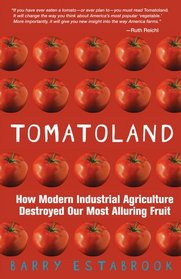Helpful Score: 2
This is one heck of an eye-opening book. I found it on a table at Barnes and Noble, and being a tomato fiend, knew I had to read it. Did you know that bland tomato in the salad you eat at McDonald's was probably picked by a slave? Yeah, me neither, at least till I read this book. There's all kinds of information to be had about tomatoes in this book: when they're picked and why, the history of tomatoes, and how the workers in the field are treated and how they should be treated. This forever changed how I will buy and eat tomatoes, and I recommend you read this too!
Helpful Score: 1
This book is a fascinating behind-the-scenes exploration of modern agriculture, and tomato production in particular. It's thorough and in-depth, even providing a history of the domestication and spread of the tomato, yet concise. It's quite an enjoyable read. I gave it 4 stars instead of 5 only because of its sloppy organization. Estabrook repeats himself occasionally, and the book reads more like a series of essays cobbled together than a single, cohesive story. It also lacks a conclusion and ends shockingly abruptly.




![header=[] body=[Get a free book credit right now by joining the club and listing 5 books you have and are willing to share with other members!] Help icon](/images/question.gif?v=52444873)
